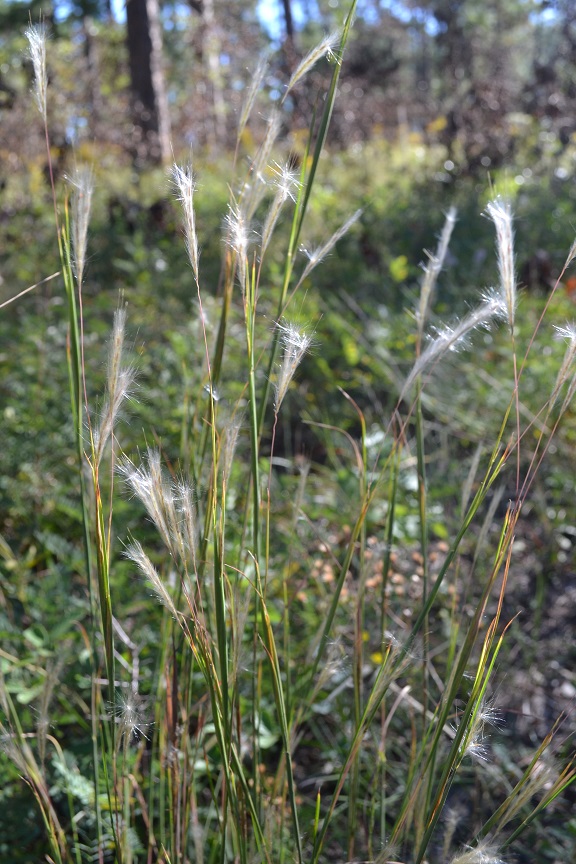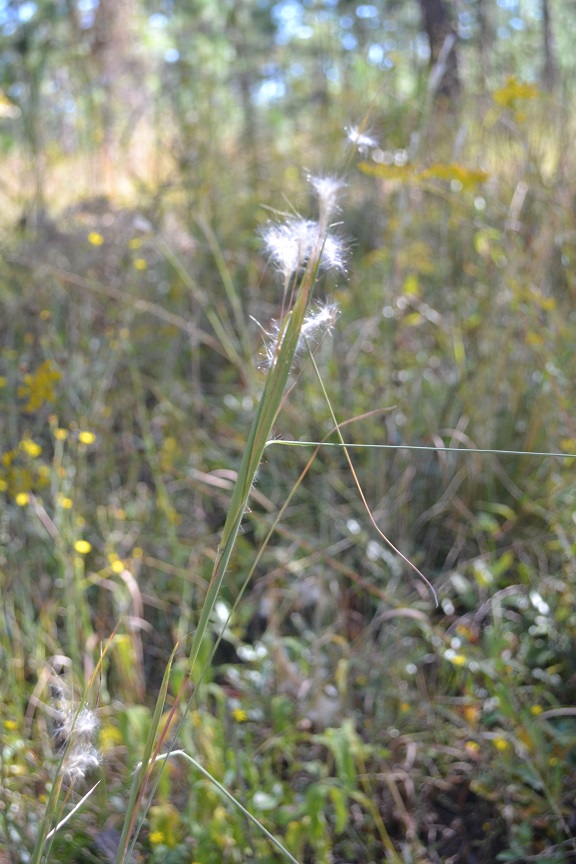Difference between revisions of "Andropogon gyrans"
HaleighJoM (talk | contribs) (→Ecology) |
(→Taxonomic notes) |
||
| Line 19: | Line 19: | ||
Common name: Elliott's bluestem | Common name: Elliott's bluestem | ||
==Taxonomic notes== | ==Taxonomic notes== | ||
| − | Synonyms: | + | Synonyms: none<ref name=weakley>Weakley, A.S. 2020. Flora of the Southeastern United States. Edition of 20 October 2020. University of North Carolina at Chapel Hill, Chapel Hill, North Carolina.</ref> |
| − | Varieties: | + | Varieties: ''A. campyloracheus'' Nash; ''A. elliottii'' Chapman; ''A. elliottii'' Chapman var. ''elliottii''; ''A. elliottii'' Chapman var. ''gracilior'' Hackel; ''A. elliottii'' Chapman var. ''projectus'' Fernald & Griscom<ref name=weakley>Weakley, A.S. 2020. Flora of the Southeastern United States. Edition of 20 October 2020. University of North Carolina at Chapel Hill, Chapel Hill, North Carolina.</ref> |
==Description== | ==Description== | ||
Revision as of 20:30, 17 May 2023
| Andropogon gyrans | |
|---|---|

| |
| Photo by Kevin Robertson | |
| Scientific classification | |
| Kingdom: | Plantae |
| Division: | Magnoliophyta - Flowering plants |
| Class: | Liliopsida – Monocotyledons |
| Order: | Poales |
| Family: | Poaceae ⁄ Gramineae |
| Genus: | Andropogon |
| Species: | A. gyrans |
| Binomial name | |
| Andropogon gyrans Ashe | |

| |
| Natural range of Andropogon gyrans from USDA NRCS Plants Database. | |
Common name: Elliott's bluestem
Contents
Taxonomic notes
Synonyms: none[1]
Varieties: A. campyloracheus Nash; A. elliottii Chapman; A. elliottii Chapman var. elliottii; A. elliottii Chapman var. gracilior Hackel; A. elliottii Chapman var. projectus Fernald & Griscom[1]
Description
Andropogon gyrans is a member of the warm-season perennial bunch grass family Poaceae and grows to heights ranging from 2.5 - 3 feet. The leaf blade is 6 - 15 inches in length, mostly smooth besides hair just above the ligule. The leaf sheath is basal, keeled, relatively narrow, overlapping, and has rounded upper sheaths. The stems are erect, with up to 6 branching near the top of the plant. The seed-head is a raceme, which is partially enclosed in a conspicuous and enlarged spathe, and turns a brown rust color when mature.[2] Number of flowers per stem can be as few as 100.[3]
Andropogon gyrans does not have specialized underground storage units apart from its rhizomes.[4] Diaz-Toribio and Putz (2021) recorded this species to have an non-structural carbohydrate concentration of 31.9 mg/g (ranking 86 out of 100 species studied).[4]
Distribution
A. gyrans is native to the southeast United States, ranging from the east coast west to Texas and Florida north up to Illinois and Pennsylvania.[2]
Ecology
Habitat
Within the Coastal Plain this species occurs in a wide range of open habitat conditions, including being a characteristic species of frequently burned longleaf pine and shortleaf pine-oak-hickory communities,[5][6] longleaf pine and pine-turkey oak sandhills, Florida scrub communities, pine flatwoods, wet savannas, wet depressions within pinelands, seepage slopes (pitcher plant bogs), calcareous (rockland) slash pine flatwoods, dune swales, shrubby wet prairies, and open cypress swamps.[7][8] Soil conditions include deep sand Entisols, sandy loam Ultisols, sandy peat Spodosols, wet Histosols (peat). This species does well in open, semi shade, and semi open light conditions and grows in large clumps together.
Andropogon gyrans var. gyrans is frequent and abundant in the Peninsula and Panhandle Xeric Sandhills, North Florida Longleaf Woodlands and Subxeric Sandhills, Clayhill Longleaf Woodlands, Panhandle Silty Longleaf Woodlands, and Upper Panhandle Savannas community types as described in Carr et al. (2010).[9]
Andropogon gyrans var. stenophyllus is an indicator species for the Peninsula Savannas and Panhandle Seepage Savannas community type. It is frequent and abundant in the Lower Panhandle Savannas community type as described in Carr et al. (2010).[10]
Associated species include longleaf pine, slash pine, wiregrass, turkey oak, Aster adnatus, Sarracenia spp., Ludwigia, Bidens, Sacciolepis, Titi, sweetgum, yaupon, and others.[8]
Phenology
Flowers summer and fall.[11] A. gyrans has been observed to flower October through January with peak inflorescence in October.[12]
Seed bank and germination
In sandhill communities, it suffers from seed germination and radical growth inhibition by allelopathic scrub species during the beginning of the rainy season.[13][14]
Fire ecology
This species is commonly found in burned pine and oak woodlands.[8] Elliott and Vose (2005) initiated a single dormant season burn (low to moderate intensity fire) on a plot containing Andropogon gyrans to see if it would stimulate growth. Additional burning may be required to stimulate its growth and the growth of other bluestem-grasses.[6] Prescribed fire and pine straw harvesting both led to increases in herbaceous plant production (including A. gyrans).[7] It is most common in native communities with minimal soil disturbance. A. gyrans was among the species that responded positively to reduction of woody vegetation using triclopyr herbicide.[15] Following a November 28, 2015 burn, resprouts were noted 38 days after the fire,[16] and populations are known to persist through repeated annual burns.[17][18]
Herbivory and toxicology
It is commonly grazed by cattle.[2] A. gyrans is also a minor source of food and occasional source of cover for terrestrial birds.[19]
Conservation, cultivation, and restoration
A. gyrans is not an abundant species to be considered a key management species, and commonly spans no more than 5 percent of overall plant composition in a community. However, proper grazing of more abundant grasses that are associated with this species maintains this proper percentage in the community.[2]
Cultural use
Photo Gallery
References and notes
- ↑ 1.0 1.1 Weakley, A.S. 2020. Flora of the Southeastern United States. Edition of 20 October 2020. University of North Carolina at Chapel Hill, Chapel Hill, North Carolina.
- ↑ 2.0 2.1 2.2 2.3 USDA NRCS (2016) The PLANTS Database (http://plants.usda.gov, 5 March 2019). National Plant Data Team, Greensboro, NC 27401-4901 USA.
- ↑ Campbell, C. S. (1983). "Wind dispersal of some North American species of Andropogon (Gramineae)." Rhodora 85(841): 65-72.
- ↑ 4.0 4.1 Diaz-Toribio, M.H. and F. E. Putz 2021. Underground carbohydrate stores and storage organs in fire-maintained longleaf pine savannas in Florida, USA. American Journal of Botany 108: 432-442.
- ↑ Clewell, A. F. (2013). "Prior prevalence of shortleaf pine-oak-hickory woodlands in the Tallahassee red hills." Castanea 78(4): 266-276.
- ↑ 6.0 6.1 Elliott, K. J. and J. M. Vose (2005). "Effects of understory prescribed burning on shortleaf pine (Pinus echinata Mill.)/mixed-hardwood forests." Journal of the Torrey Botanical Society 132: 236-251.
- ↑ 7.0 7.1 Haywood, J. D. (2012). "Pine straw harvesting, fire, and fertilization affect understory vegetation within a Louisiana longleaf pine stand." Southern Journal of Applied Forestry 36: 130-135.
- ↑ 8.0 8.1 8.2 Florida State University Robert K. Godfrey Herbarium database. URL: http://herbarium.bio.fsu.edu. Last accessed: June 2014. Collectors: Robert K. Godfrey, Neal Morar, Sidney McDaniel , Loran C. Anderson, R. Kral, Ann F. Johnson, C.S. Campbell, John Morrill, O. Lakela, A.H. Curtiss, H.F. Lamp, R. E. Perdue, Jr., Austin Mast, Michael R. Jenkins, John G. Palis, J. M. Kane, Ed Keppner, Lisa Keppner, Angus Gholson, Wilson Baker, and A. F. Clewell. States and Counties: Florida: Wakulla, Gilchrist, Leon, Franklin, Calhoun, Liberty, Nassau, Bay, Jackson, Madison, Putnam, Hillsborough, Walton, Okaloosa, Duval, Highlands, Manatee, Clay, Monroe, Santa Rosa, and Jefferson. Georgia: Thomas, Grady, and Colquitt.
- ↑ Carr, S.C., K.M. Robertson, and R.K. Peet. 2010. A vegetation classification of fire-dependent pinelands of Florida. Castanea 75:153-189.
- ↑ Carr, S.C., K.M. Robertson, and R.K. Peet. 2010. A vegetation classification of fire-dependent pinelands of Florida. Castanea 75:153-189.
- ↑ http://www.namethatplant.net/plantdetail.shtml?plant=83
- ↑ Nelson, G. PanFlora: Plant data for the eastern United States with emphasis on the Southeastern Coastal Plains, Florida, and the Florida Panhandle. www.gilnelson.com/PanFlora/ Accessed: 5 MAR 2019
- ↑ Richardson, D. R. (1985). Allelopathic effects of species in the sand pine scrub of Florida (fire). Ecology. Ann Arbor, MI, University of South Florida. Ph.D.: 135.
- ↑ Richardson, D. R. and G. B. Williamson (1988). "Allelopathic effects of shrubs of the sand pine scrub on pines and grasses of the sandhills." Forest Science 34: 592-605.
- ↑ Miller, J. H., R. S. Boyd, et al. (1999). "Floristic diversity, stand structure, and composition 11 years after herbicide site preparation." Canadian Journal of Forest Research 29: 1073-1083.
- ↑ Observation by Edwin Bridges January 5, 2016, posted to Florida Flora and Ecosystematics Facebook Group January 6, 2016.
- ↑ Robertson, K.M. Unpublished data collected from Pebble Hill Fire Plots, Pebble Hill Plantation, Thomasville, Georgia.
- ↑ Glitzenstein, J. S., D. R. Streng, R. E. Masters, K. M. Robertson and S. M. Hermann 2012. Fire-frequency effects on vegetation in north Florida pinelands: Another look at the long-term Stoddard Fire Research Plots at Tall Timbers Research Station. Forest Ecology and Management 264: 197-209.
- ↑ Miller, J.H., and K.V. Miller. 1999. Forest plants of the southeast and their wildlife uses. Southern Weed Science Society.
